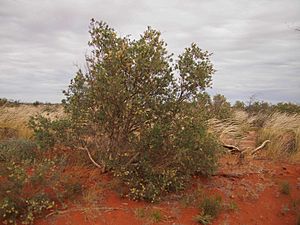Melaleuca lasiandra facts for kids
Quick facts for kids Melaleuca lasiandra |
|
|---|---|
 |
|
| Melaleuca lasiandra habit | |
| Scientific classification | |
| Genus: |
Melaleuca
|
| Species: |
lasiandra
|
Melaleuca lasiandra is a special plant that belongs to the myrtle family, called Myrtaceae. You can find it growing naturally in the northern inland parts of Australia. This plant is quite unique because its leaves are covered with soft, silky hairs. These hairs make the leaves look silvery-grey. Even the tiny parts of its flowers, called stamens, are hairy!
Contents
What it Looks Like
Melaleuca lasiandra can be a large bush or a small tree. It can grow up to 8 metres (26 ft) tall. It has white or grey bark that feels like paper.
Leaves and Flowers
The leaves of this plant are shaped like a narrow oval, with a small pointed tip. They are about 10–50 millimetres (0.39–1.97 in) long and 1.5–10 millimetres (0.059–0.394 in) wide. They have so many fine hairs that they look silvery-grey.
The flowers are usually yellowish-green or white. They grow in clusters at the ends of branches. These branches keep growing even after the flowers bloom. You can also find flowers growing where the leaves meet the stem (these spots are called upper leaf axils). Each flower cluster is about 22 millimetres (0.87 in) across and has between 2 and 11 groups of flowers, usually in threes.
Stamens and Fruit
Inside the flowers, the stamens (the parts that produce pollen) are grouped into five bundles. Each bundle has 6 to 20 stamens, and their stalks are hairy. Melaleuca lasiandra flowers on and off throughout the year, but it blooms most often in winter.
After the flowers, the plant produces woody capsules which are its fruit. These capsules are shaped like a cup and are about 2–3 millimetres (0.079–0.118 in) long. When they first form, they have small "teeth" from the sepals (leaf-like parts that protect the flower bud). Later, these teeth wear away, leaving wavy edges around the cup. The capsules grow in loose clusters along the branches.
Its Name and Discovery
The scientific name Melaleuca lasiandra was first officially described in 1862 by a scientist named Ferdinand von Mueller. He wrote about it in his book "Fragmenta Phytographiae Australiae".
Meaning of the Name
The second part of its name, lasiandra, comes from two ancient Greek words. "Lasios" means "hairy" or "woolly," and "anēr" (which becomes "andros" in this case) means "male." This name was chosen because the plant's stamens, which are the "male" parts of the flower, are very hairy.
Where it Grows
This type of melaleuca tree grows in the tropical northern parts of Australia. You can find it in the northern half of Western Australia, across the Northern Territory, and in the central-west of Queensland. It can grow in many different kinds of soil and in various plant communities. It is often found in the dips and low areas between sand dunes.
Conservation Status
The Government of Western Australia's Department of Parks and Wildlife has listed Melaleuca lasiandra as "not threatened." This means that there are enough of these plants in the wild, and they are not currently in danger of disappearing.
Growing it at Home
Melaleuca lasiandra is a tough plant that can be grown in dry areas. If you want to grow it, it needs lots of sunshine and soil that drains water well.
Images for kids



